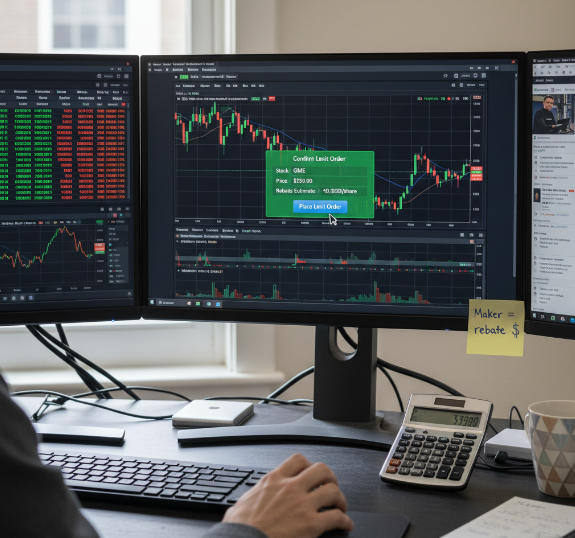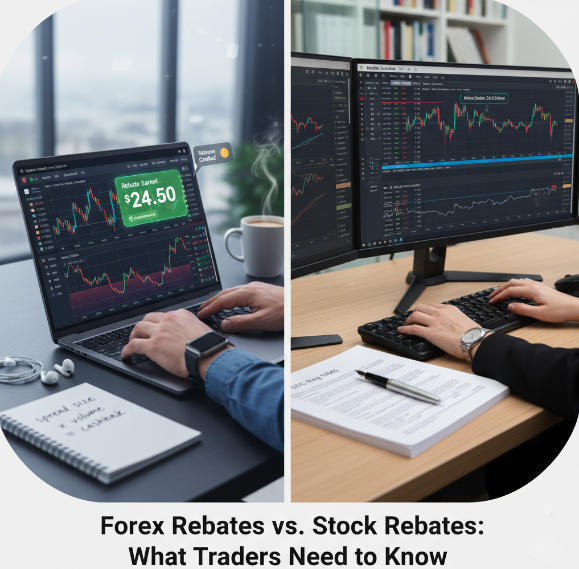Table of Contents
Ever heard of folks getting paid just for trading? That’s the magic behind rebate trading. It’s like scoring cash back every time you shop—only here, the “store” is your broker, and your “purchases” are trades. In a market where fees quietly nibble at profits, rebate trading flips the script and hands a slice of those costs right back to you.
As CNBC once put it, “Liquidity isn’t free—but it can pay you back.” That’s the whole idea. By placing limit orders that help keep markets flowing, traders can earn rebates from exchanges or brokers. It’s not just a bonus; it’s a way to turn every smart order into a micro-income stream.
If trading feels like running on a treadmill, rebate trading is that little tailwind that helps you move ahead. It won’t make you rich overnight, but it can make each trade count for more—especially when you know the tricks, risks, and sweet spots that set winning rebate traders apart.
What is Rebate Trading?

In the words of Michael Lane, a senior liquidity strategist with over two decades of experience in institutional trading desks, “Rebate trading is not a side hustle; it is a precision game of flow, incentives, and margins.”
Rebate trading refers to a practice where traders earn small payments — rebates — from brokers or exchanges for adding liquidity to the market. This typically occurs when a trader places a limit order that does not immediately execute but instead sits in the order book, offering counterparties a chance to fill it. When that happens, the trader receives a rebate, usually a fraction of a cent per share.
From a retail trader’s lens, as shared by day trader Susan Heller in her recent podcast interview, “I started seeing rebates as a bonus. I was not just trading to beat price levels. I was being paid for patience.”
To understand why these incentives exist, one must look at market makers and order flow. Exchanges reward traders for providing liquidity because it improves execution quality for others. This dynamic creates a multi-layered market where professionals leverage rebates not just for side income, but as a core profitability component.
Key elements of rebate trading:
Involves working with brokers offering commission structures that support rebates (often via the maker–taker model)
Relies heavily on the trader’s order type and execution priority
Connects deeply with liquidity depth and price improvement mechanics
Offers profit opportunities even when price movement is minimal
Experts like Nasdaq market architect Jeff Harris have noted, “Liquidity rebates drive tighter spreads. This is not a gimmick — it is a structural feature of modern markets.”
The practice thrives in environments with ultra-low margins, where volume, speed, and precision matter more than directional calls. When executed skillfully, rebate trading becomes a bridge between active speculation and professional-grade market making.
Traders considering this path should evaluate:
Their broker’s rebate policy
Fee structures and ECN access (see: What Is an ECN Broker?)
Execution strategy alignment with market liquidity
This is not a plug-and-play technique. It is a deliberate, measured tactic backed by a clear understanding of how market structure, execution mechanics, and incentives interlace.
How much can rebates earn you?

Rebate trading can be profitable, but your earnings depend on several key variables. Let’s break it down by broker type, trading volume, hidden costs, and real-world case studies.
Rebate amounts by broker type
Rebate amounts vary widely depending on the broker type.
Full-service brokers often offer lower rebate percentages, since they rely on higher commission structures and add-on services.
Discount brokers and ECN brokers, on the other hand, are more generous with rebates, especially for high-volume clients.
| Broker Type | Avg. Rebate (%) | Typical Commission Model |
|---|---|---|
| Full-service | 0.1 – 0.3% | Fixed + Service Fee |
| Discount | 0.4 – 0.8% | Volume-based |
| ECN | 0.5 – 1.2% | Spread or Flat Fee |
Impact of trading volume on rebates
Your trading volume heavily influences rebate potential. Most brokers use rebate tiers, rewarding higher volume with better rebate scaling.
Here’s how it usually works:
Volume thresholds are set monthly or weekly.
Crossing a higher tier boosts your per-trade rebate.
High-frequency trading often unlocks the top tiers.
Example: A trader executing 100,000 trades/month may earn twice the rebate of someone doing 5,000, thanks to aggressive tier bonuses.
Hidden costs affecting rebate profit
It ain’t all gravy — there’s a catch. Even with juicy rebates, hidden costs can chew into your profits:
Slippage from volatile markets
Platform or subscription fees
Broker commissions
Tax implications on rebate income
Opportunity cost of suboptimal trades
“Traders often overlook what they’re actually spending to earn those rebates,” says Jake Nguyen, lead analyst at AlgoMetrics. “That’s where profits vanish.”
Real examples of rebate earnings
Let’s look at two realistic trader profiles:
Anna uses a mid-frequency strategy, trades ~$250K/month. After broker fees and slippage, she earns $110/month in rebate earnings — a nice buffer against costs.
Marcus, a scalper with $2M/month in investment amounts, nets $980/month through rebates, as his strategy fits tight ECN models.
Both cases show that profitability relies not just on volume but on aligning trading strategies with the right rebate structures.
Passive orders, active rewards?

Learn how rebate trading flips the script—get paid for placing trades instead of paying to play.
1. Limit orders and maker rebates
Limit orders don’t just get you better control—they can earn you maker rebates for adding liquidity to the order book. It’s like being paid to wait.
Passive orders are queued on the book until matched, unlike aggressive market orders.
Market making strategies rely heavily on this system.
Some traders “surf” the spread purely for the rebate—profitable in high-frequency settings.
As one Reddit user joked:
"I’m not trading stocks, I’m farming rebates!"
In rebate trading, it’s not always about direction—it’s about positioning.
2. Exchange fee structures explained
Understanding exchange fee structures is key to optimizing your rebate game. Most exchanges use the maker–taker model, rewarding liquidity providers.
| Exchange | Maker Fee | Taker Fee |
|---|---|---|
| NYSE Arca | -$0.0020/share | $0.0030/share |
| Nasdaq | -$0.0015/share | $0.0029/share |
| BATS (Cboe) | -$0.0025/share | $0.0030/share |
Tiered fees adjust based on trading volume (see examples from Cboe and NYSE Arca Options).
High-volume traders may unlock better rebate rates.
Read the fee schedule—small differences impact big trades.
3. When passive trading outperforms active
Sometimes, the tortoise really does beat the hare. In choppy or sideways markets, passive trading can outperform aggressive strategies. Here's how:
Avoid slippage: Passive orders don’t chase price.
Collect rebates: Maker orders may earn money (see SEC overview of maker–taker).
Lower risk: Smaller, controlled entries reduce exposure.
✅ Great during low volatility ❌ Weak when markets break out fast
"Active trading is a sprint. Passive trading is long-distance running—with cashback." — Elena Vargo, Trading Strategy Analyst at ArcExchange
Forex rebates vs stock rebates

“I tried both—switched from forex to stocks last year,” shares Elijah Monroe, a prop trader with seven years under his belt. “There is a lot more going on behind those rebate numbers than people think.”
Forex rebates and stock rebates sound alike, but the way they operate reveals sharp differences. In forex, traders receive a portion of the spread or commission back as cashback, usually through a third-party partner or directly from the broker. The rebate often increases with higher trading volume, incentivizing constant participation in fast-moving markets with high leverage (see third-party explanations such as CashbackForex and BlackBull Partners).
In the stock world, the rebate game leans on market structure. Traders placing passive orders through ECNs may earn maker rebates. This encourages liquidity provision. Yet, the rebates are often offset by exchange fees, tiered commission structures, and strict regulation, particularly in U.S. equity markets (background: SEC Reg NMS and access fee caps).
Key contrasts:
Forex rebates: tied to spread size, paid per trade, common in decentralized asset classes.
Stock rebates: based on order type, paid for adding liquidity, influenced by exchange rules (see Investopedia: Maker–Taker).
According to CME Group, regulatory oversight in equities limits excessive rebate incentives, citing concerns over fairness and quote manipulation.
“Forex feels freer,” Elijah adds. “Stocks make you work harder for every penny in rebates.” His feedback echoes across trader forums where cashback hunters weigh flexibility against compliance.
For traders comparing forex rebates and stock rebates, knowing the structure, broker incentives, and market rules may be the edge that turns cents into real profit.
Conclusion
Rebate trading’s kind of like getting cashback for being smart with your timing. If you’re already placing a ton of trades, especially using limit orders, those small rebates can stack up faster than you'd think. It’s not a get-rich-quick deal, but for high-volume or algorithmic traders, it’s free money left on the table (learn more about the maker–taker model).
“Good traders focus on edge—rebates are one,” says market veteran Linda Raschke.
Still, it ain’t for everyone. If you're not watching fees, or you're forcing trades just to chase rebates, you could end up hustling backwards.
FAQ
Rebate trading is a trading method where traders earn small cash payments (rebates) from exchanges or brokers for providing liquidity. Essentially, you get paid for placing limit orders that help stabilize the market. Over time, these small rebates can add up — especially for high-volume traders.
When you place a limit order, you’re adding liquidity to the market. Exchanges reward this by offering a rebate, usually a few cents per share or a fraction of a pip in forex. On the other hand, traders who remove liquidity (market takers) often pay a small fee instead.
Not quite. Forex rebates are usually offered through brokers as a percentage of the spread or commission you pay.
In stock trading, rebates often come directly from electronic communication networks (ECNs). Both serve the same purpose — encouraging liquidity — but the mechanics differ slightly.
High-frequency traders can earn hundreds or even thousands monthly.
Retail traders might make a modest side income that offsets commissions.
The key is consistency — rebate profits scale with trade volume.
This structure incentivizes “makers” to keep the market active and liquid.
Maker: Adds liquidity by placing limit orders → earns rebates.
Taker: Removes liquidity by executing market orders → pays a fee.
No — while rebates can offset costs, they don’t eliminate trading risk.
You can still lose money on price movements, overtrading, or chasing volume purely for rebates. The most successful rebate traders balance strategy, volume, and risk management carefully.
Always review fine print — some “rebate” deals are simply marketing tactics with higher spreads.
Brokers with transparent fee and rebate schedules (e.g., IC Markets, Pepperstone).
ECNs that clearly show maker-taker pricing models.
Yes, but cautiously. Beginners should first understand basic order types, spreads, and liquidity concepts before focusing on rebates. For new traders, it’s better to learn execution quality and risk control — rebates should come later as part of a cost optimization strategy.
